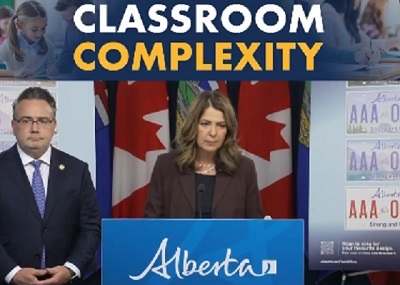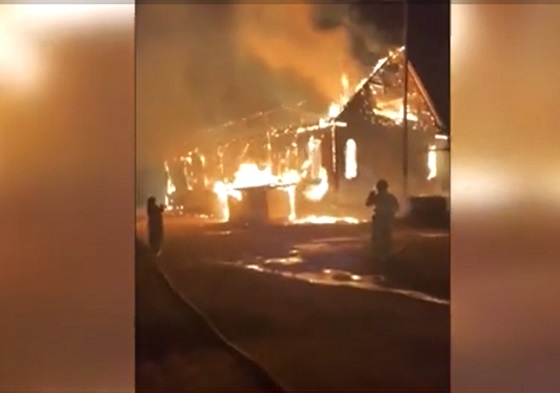Alberta
Report commissioned by Alberta’s Smith calls for end to COVID shots for healthy minors

From LifeSiteNews
A 269-page report commissioned by Alberta Premier Danielle Smith has recommended halting the use of the COVID vaccines in healthy children and teenagers.
A report commissioned by Alberta Premier Danielle Smith to investigate the previous administration’s handling of COVID-19 was released to the public late last week and included a recommendation to immediately halt the experimental jabs for healthy children and teenagers.
The Alberta COVID-19 Pandemic Data Review Task Force’s “COVID Pandemic Response” 269-page final report was released last Friday, recommending the halting of “the use of COVID-19 vaccines without full disclosure of their potential risks” as well as outright ending their use “for healthy children and teenagers as other jurisdictions have done,” mentioning countries like “Denmark, Sweden, Norway, Finland, and the U.K.”
The report also called for “[f]urther research to establish the safety and efficacy of COVID-19 vaccines is necessary before widespread use in adults and children,” the establishment of “a website and/or call-in center for the vaccine injured in Alberta” as well as establishing a “mechanism for opting out of federal health policy until provincial due process has been satisfied.”
The task force also found that the COVID jabs were not “designed to halt transmission” and that there is a “lack of reliable data showing that the vaccines protect children from COVID-19.”
“The Task Force found that the risk of severe COVID-19 infection or death is primarily associated with age, with the elderly being most at risk,” reads the report.
“Children and teenagers have a very low risk of serious illness from COVID-19. COVID-19 vaccines were not designed to halt transmission and there is a lack of reliable data showing that the vaccines protect children from severe COVID-19.”
The report was released with no fanfare nor mention from any Alberta government official, perhaps suggesting that officials do not want to draw attention to the report.
The report was compiled by a panel of physicians and others in the health services sector. It was headed by Dr. Gary Davidson, who served as the former chief of emergency medicine at the Red Deer Regional Hospital Centre.
When it comes to the COVID shots, the task force found “deaths” and “injuries” related to the jabs.
“In terms of safety, the task force identified reports of deaths and injuries attributed to the vaccines, as well as a known risk of myocarditis, particularly in young males,” reads the report.
“The long-term safety of the vaccines is undetermined due to their rapid deployment and limited follow-up.”
The review of the COVID jabs in Alberta found that careful assessment of “risks and benefits, transparency, and individual choice in decision-making are vital for any future pandemic response vaccination initiative.”
It is worth noting that Alberta Health Services (AHS) is still promoting the COVID shots for babies as young as six months old.
The report stated that its main goal was to examine the “quality, use, interpretation, and flow of information and data that informed Alberta’s pandemic response to COVID-19.”
Smith, who spoke out against COVID jab mandates early in her term as premier, gave the task force a sweeping mandate last year to look at whether the “right data” was obtained during COVID and to assess the “integrity, validity, reliability and quality of the data/information used to inform pandemic decisions” by members of AHS.
Smith took over from Jason Kenney as leader of the UCP and premier on October 11, 2022, after winning the leadership of the party. The UCP then won a general election in May 2023. Kenney was ousted due to low approval ratings and for reneging on promises not to lock Alberta down during COVID.
After assuming her role as premier, Smith promptly fired the province’s top doctor, Deena Hinshaw, and the entire AHS board of directors, all of whom oversaw the implementation of COVID mandates.
Under Kenney, thousands of nurses, doctors, and other healthcare and government workers lost their jobs for choosing to not get the jabs, leading Smith to say – only minutes after being sworn in – that over the past year the “unvaccinated” were the “most discriminated against” group of people in her lifetime.
Thus far, Smith has not commented on the findings of the report.
Report critical of provincial response to COVID, notes masks were not ‘effective’
The task force concluded that it found a “critical failure of Alberta’s health system,” sharing concerns about how information was shared and developed during the COVID pandemic.
The report also noted that face masks, including both N95 and surgical masks, were not effective in stopping respiratory illness, and that there is a “weak evidence base for the effectiveness of continuous masking in preventing respiratory illnesses, including COVID-19.”
“Alberta should acknowledge the absence of evidence showing continuous masking provides protection against respiratory illnesses, including COVID-19, and highlight the potential harms associated with masking,” reads the report.
The report emphasized that the “choice to wear a mask should be a personal medical decision, guided by informed consent.”
The report also criticized lockdown policies and Alberta’s medical regulatory colleges for not doing their “due diligence” when it came to looking at producing their own internal studies related to COVID.
LifeSiteNews has published an extensive amount of research on the dangers of the experimental COVID mRNA jabs, which include heart damage and blood clots.
The mRNA shots have also been linked to a multitude of negative and often severe side effects in children and all have connections to cell lines derived from aborted babies.
Alberta
Alberta taxpayers should know how much their municipal governments spend

From the Fraser Institute
By Tegan Hill and Austin Thompson
Next week, voters across Alberta will go to the polls to elect their local governments. Of course, while the issues vary depending on the city, town or district, all municipal governments spend taxpayer money.
And according to a recent study, Grande Prairie County and Red Deer County were among Alberta’s highest-spending municipalities (on a per-person basis) in 2023 (the latest year of comparable data). Kara Westerlund, president of the Rural Municipalities of Alberta, said that’s no surprise—arguing that it’s expensive to serve a small number of residents spread over large areas.
That challenge is real. In rural areas, fewer people share the cost of roads, parks and emergency services. But high spending isn’t inevitable. Some rural municipalities managed to spend far less, demonstrating that local choices about what services to provide, and how to deliver them, matter.
Consider the contrast in spending levels among rural counties. In 2023, Grande Prairie County and Red Deer County spent $5,413 and $4,619 per person, respectively. Foothills County, by comparison, spent just $2,570 per person. All three counties have relatively low population densities (fewer than seven residents per square kilometre) yet their per-person spending varies widely. (In case you’re wondering, Calgary spent $3,144 and Edmonton spent $3,241.)
Some of that variation reflects differences in the cost of similar services. For example, all three counties provide fire protection but in 2023 this service cost $56.95 per person in Grande Prairie County, $38.51 in Red Deer County and $10.32 in Foothills County. Other spending differences reflect not just how much is spent, but whether a service is offered at all. For instance, in 2023 Grande Prairie County recorded $46,283 in daycare spending, while Red Deer County and Foothills County had none.
Put simply, population density alone simply doesn’t explain why some municipalities spend more than others. Much depends on the choices municipal governments make and how efficiently they deliver services.
Westerlund also dismissed comparisons showing that some counties spend more per person than nearby towns and cities, calling them “apples to oranges.” It’s true that rural municipalities and cities differ—but that doesn’t make comparisons meaningless. After all, whether apples are a good deal depends on the price of other fruit, and a savvy shopper might switch to oranges if they offer better value. In the same way, comparing municipal spending—across all types of communities—helps Albertans judge whether they get good value for their tax dollars.
Every municipality offers a different mix of services and those choices come with different price tags. Consider three nearby municipalities: in 2023, Rockyview County spent $3,419 per person, Calgary spent $3,144 and Airdrie spent $2,187. These differences reflect real trade-offs in the scope, quality and cost of local services. Albertans should decide for themselves which mix of local services best suits their needs—but they can’t do that without clear data on what those services actually cost.
A big municipal tax bill isn’t an inevitable consequence of rural living. How much gets spent in each Alberta municipality depends greatly on the choices made by the mayors, reeves and councillors Albertans will elect next week. And for Albertans to determine whether or not they get good value for their local tax dollars, they must know how much their municipality is spending.
Alberta
Premier Smith addresses the most important issue facing Alberta teachers: Classroom Complexity

Premier Danielle Smith is posting this response to a media question about Classroom Complexity.
While Albertans are hearing a lot about capping class sizes, Premier Smith says it might be a much better idea to talk about capping “complexity”.
The challenges teachers face in today’s classrooms are recognized, and work continues toward practical solutions that address their concerns.
Achieving a fair and reasonable agreement that best supports students remains a top priority. pic.twitter.com/o4UCt7sDoU
— Danielle Smith (@ABDanielleSmith) October 16, 2025
-

 Red Deer19 mins ago
Red Deer19 mins agoThe City of Red Deer’s Financial Troubles: Here Are The Candidates I Am Voting For And Why.
-

 Alberta2 days ago
Alberta2 days agoClick here to help choose Alberta’s new licence plate design
-

 National2 days ago
National2 days agoDemocracy Watch Renews Push for Independent Prosecutor in SNC-Lavalin Case
-

 International2 days ago
International2 days agoDaughter convinces healthy father to die in double assisted suicide with mother
-

 illegal immigration2 days ago
illegal immigration2 days agoLos Angeles declares a state of emergency over ICE deportations
-

 International2 days ago
International2 days agoHamas will disarm or die
-

 International2 days ago
International2 days agoUS Warns Hamas To Halt Executions
-

 Indigenous1 day ago
Indigenous1 day agoConstitutional lawyer calls for ‘false’ claims to end in Canadian residential schools burials







